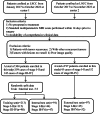Multiparameter MRI-based model integrating radiomics and deep learning for preoperative staging of laryngeal squamous cell carcinoma
- PMID: 40346120
- PMCID: PMC12064683
- DOI: 10.1038/s41598-025-01270-1
Multiparameter MRI-based model integrating radiomics and deep learning for preoperative staging of laryngeal squamous cell carcinoma
Abstract
The accurate preoperative staging of laryngeal squamous cell carcinoma (LSCC) provides valuable guidance for clinical decision-making. The objective of this study was to establish a multiparametric MRI model using radiomics and deep learning (DL) to preoperatively distinguish between Stages I-II and III-IV of LSCC. Data from 401 histologically confirmed LSCC patients were collected from two centers (training set: 213; internal test set: 91; external test set: 97). Radiomics features were extracted from the MRI images, and seven radiomics models based on single and combined sequences were developed via random forest (RF). A DL model was constructed via ResNet 18, where DL features were extracted from its final fully connected layer. These features were fused with crucial radiomics features to create a combined model. The performance of the models was assessed using the area under the receiver operating characteristic (ROC) curve (AUC) and compared with the radiologist performances. The predictive capability of the combined model for Progression-Free Survival (PFS) was evaluated via Kaplan-Meier survival analysis and the Harrell's Concordance Index (C-index). In the external test set, the combined model had an AUC of 0.877 (95% CI 0.807-0.946), outperforming the DL model (AUC: 0.811) and the optimal radiomics model (AUC: 0.835). The combined model significantly outperformed both the DL (p = 0.017) and the optimal radiomics models (p = 0.039), and the radiologists (both p < 0.050). Moreover, the combined model demonstrated great prognostic predictive value in patients with LSCC, achieving a C-index of 0.624 for PFS. This combined model enhances preoperative LSCC staging, aiding in making more informed clinical decisions.
Keywords: Cancer staging; Deep learning; Laryngeal squamous cell carcinoma; Multiparametric MRI; Radiomics.
© 2025. The Author(s).
Conflict of interest statement
Declarations. Competing interests: The authors declare no competing interests.
Figures







References
-
- Bray, F. et al. Global cancer statistics 2022: GLOBOCAN estimates of incidence and mortality worldwide for 36 cancers in 185 countries. CA A Cancer J. Clin.74, 229–263. 10.3322/caac.21834 (2024). - PubMed
-
- Obid, R., Redlich, M. & Tomeh, C. The treatment of laryngeal cancer. Oral Maxillofac. Surg. Clin. North Am.31, 1–11. 10.1016/j.coms.2018.09.001 (2019). - PubMed
-
- Itamura, K., Hsue, V. B., Barbu, A. M. & Chen, M. M. Diagnostic assessment (Imaging) and staging of laryngeal Cancer. Otolaryngol. Clin. North Am.56, 215–231. 10.1016/j.otc.2022.12.006 (2023). - PubMed
MeSH terms
Grants and funding
LinkOut - more resources
Full Text Sources
Medical

